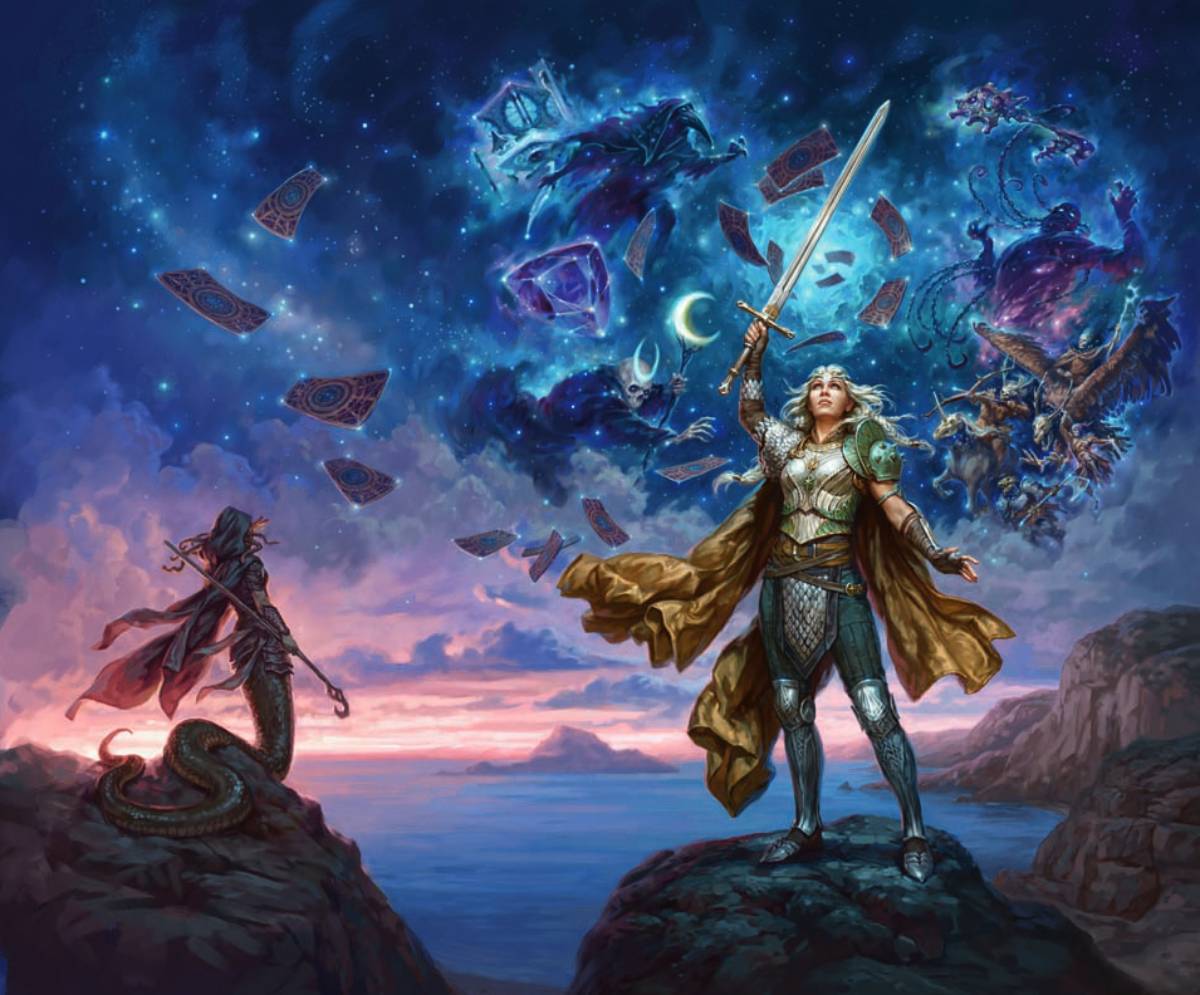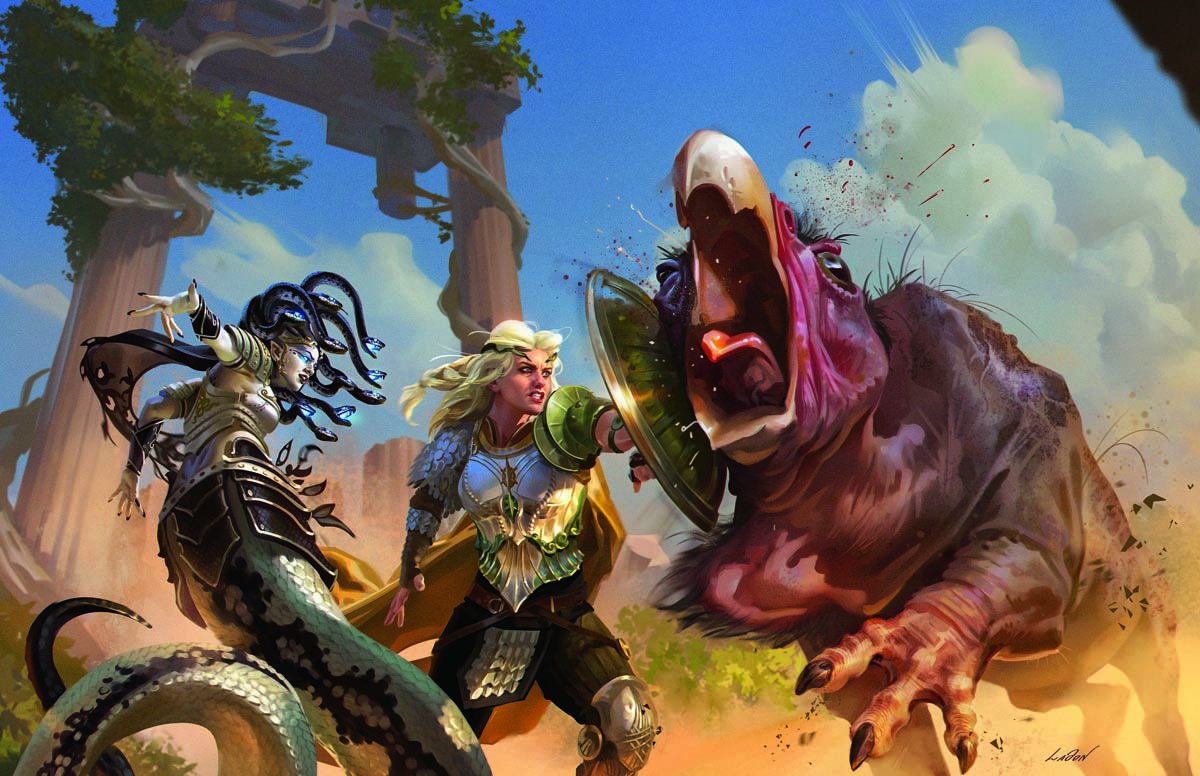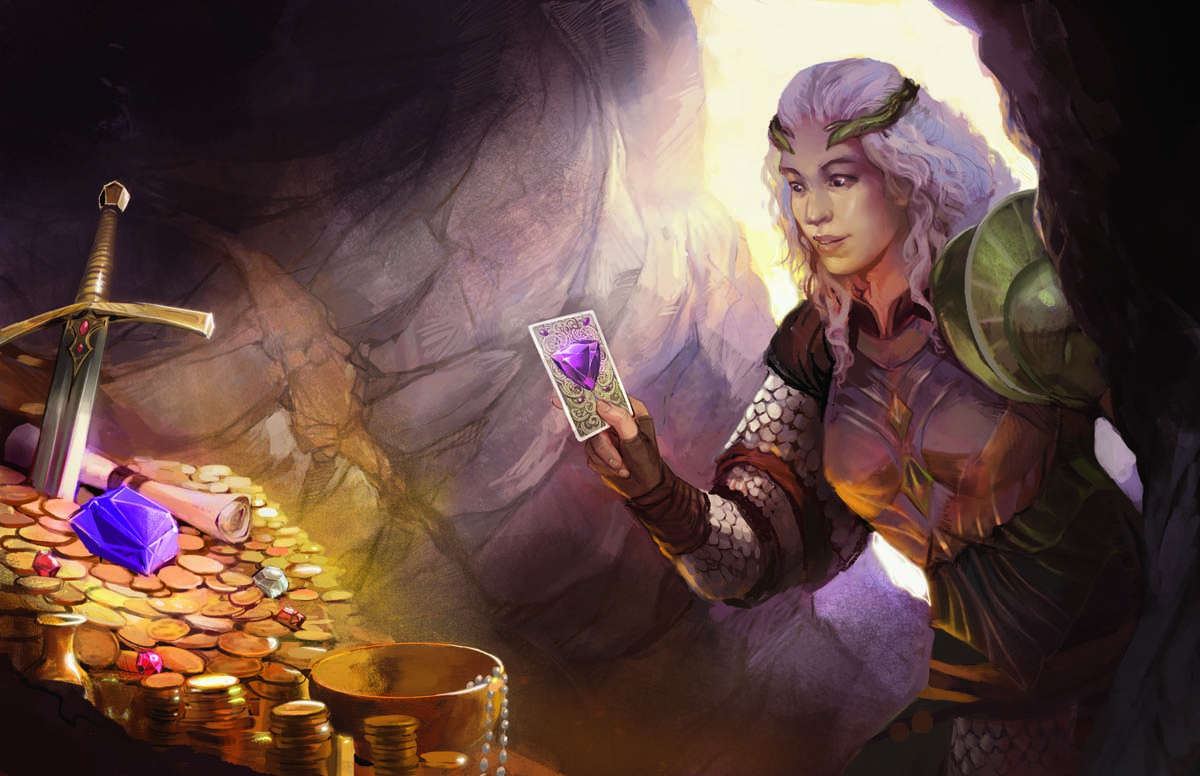As an autistic player and Dungeon Master, the moment I saw the announcement that The Book of Many Things featured the first canonically autistic character, I screamed with excitement. This feeling grew when I discovered Asteria, this first autistic character, was created by autistic designer Makenzie De Armas.
I got to talk with Makenzie about creating Asteria for The Book of Many Things, autistic representation in the game, and connecting this character to the Deck of Many Things. Two autistic folks getting to dig into some of their special interests? Best. Thing. Ever. Let’s dive right in!
- Who Is Asteria?
- The Process of Creating the First Canonically Autistic Character
- Aiming for Authentic Autistic Representation
- Asteria, Fate, and Friendship
- The Word ‘Autistic’ Isn’t Used in the Book
Unleash Chaos With The Deck of Many Things Set
Pick a card, any card! The Deck of Many Things set expands on the legendary Deck of Many Things with new player options, monsters, and more! Included in the set is the 192-page The Book of Many Things, an expanded 66-card Deck of Many Things, and a guidebook for using the cards in new and fun ways.
Who Is Asteria?

Asteria is the powerful warrior figure on the cover of The Book of Many Things. She is the original recipient of the first Deck of Many Things. Though a princess of a faraway coastal kingdom, her childhood is a story many autistic folks will relate to: Asteria grew up with a strict definition of who she was supposed to be but, much to her father’s chagrin, she never fit the mold of the ideal child. She didn’t play with other children like she was supposed to, or have the same interests as them. She didn’t make eye contact, and was fixated on the stars above her, instead of the people around her.
After years of her father trying to force his idealized vision of a child onto Asteria, The Book of Many Things tells us, “The princess grew up isolated and independent, resenting the unending pressure others placed on her to be someone other than herself.” Dearest autistic readers, your mileage may vary but I have never before felt so deeply seen by a single sentence. It me.
As the story continues, Asteria was out for a swim when she was swept miles away by a rip current. After being battered against the rocky coast, the waves carried her into a secret grotto where she met Euryale, a medusa. Euryale, exhausted by being constantly seen as monstrous, also felt isolated and alone, and the two young women quickly connected on a deep level. “Their existences blissfully intertwined for years, with neither forcing the other to be anything but themselves,” The Book of Many Things reads. It was this relationship of found family that led to the creation of the Deck of Many Things. We’ll dig deeper into that part of Asteria’s story in a moment.
The Process of Creating the First Canonically Autistic Character

In the process of deciding who was going to be the book’s narrator, Makenzie, together with the book’s lead, Jason Tondro, looked through the Deck of Many Things and saw that out of the 22 standard cards, there was only one with a proper name: Euryale.
“So we knew we wanted to do something with Euryale and the medusa symbol,” Makenzie said, sharing that the team wanted to honored the way it has been “wonderfully reclaimed by numerous survivors of sexual assault and violence.” Approaching the medusa “as a symbol of protection and sisterhood and defiance” led them to create a new character, a paladin, to wield the symbol. The team worked backwards to figure out how this new character could connect to Euryale, and brainstormed circumstances that might lead to a close friendship with a medusa.
“It sort of flashed in my head of, oh, the Petrifying Gaze works with eye contact,” Makenzie said, “so if you never really make eye contact, it's a lot easier and a lot less risk to being friends with a medusa. Because even though the medusa in our game can control their Petrifying Gaze at will, it probably helps to have a friend who doesn't make eye contact because then you don't accidentally trigger it.”
After this flash of inspiration, Makenzie almost shelved the idea, concerned this kind of autistic representation might end up as a joke or a gimmick. She was doubly concerned because medusa stories are also rife with problematic disability representation, where a blind person lacks a personality beyond being a blind love interest. “I didn't want to make a disabled storyline where the [character’s disability] is just a shortcut in the story,” she explained. As this new character was developed, however, her story became one of a person living under rigid expectations of who she was supposed to be, learning who she really was, and using that knowledge to resolutely define her own story. “And then I realized that's a deeply autistic experience.” Makenzie went on to explain, “And then that's when we decided it works. She can be autistic, and it's not just a joke.”
Aiming for Authentic Autistic Representation

Autistic representation in media has frequently parroted harmful stereotypes for cheap laughs. Asteria, though, stands out to me as one of the few autistic characters that feels authentic and beautiful because she was created by an autistic designer.
When it comes to her design in general, Makenzie’s autism informs her approach to her design work, but being autistic is not the entirety of who she is. “It's one of those things where I don't want to end up being the exceptional case. I don't want it to ever seem like I'm doing something in spite of my autism. I want it to be like, I'm doing a thing. I'm also autistic.” That sentiment is reflected in the balanced way Makenzie wrote the little notes Asteria has left scattered throughout the book; about half of them specifically build Asteria’s personality and interests beyond her autism. For example, Asteria shares her thoughts adoring flumphs, admires Tasha’s “snark and style,” and she also waxes poetic about finding your purpose and the meaningful nature of even the shortest friendships.
In the half of the notes where Makenzie does reference Asteria’s autism, she deftly sidesteps stereotypes by choosing specifics over generalities. “I think [specificity] is the key to avoiding stereotypes,” she says. “Those generalities come from a lot of different unique experiences conglomerated because they have some similarities. So it's picking out that very distinct, specific experience that helps subvert these stereotypes.”
For example, instead of making Asteria broadly interested in mathematics and science, Makenzie gave her specific interests in astronomy and constellations. Additionally, many of Asteria’s autistic traits are portrayed in such a natural way that it’s clear they come from a personally autistic experience. In one note, Asteria talks about being so hyper-focused that she forgets to eat, and in another, she lists wax earplugs as “essential adventuring equipment” for dealing with noise. (I’m writing this with my own trusty earplugs solidly stuffed into my ears and with my untouched breakfast sitting beside me.) Some notes are even written in a short, abrupt way to reflect that Asteria is overstimulated and battling an autistic meltdown. One reads: “We fought. I survived. I couldn't speak for days afterwards.”
Makenzie also drew on one of her current hyperfixations to answer the question of how Asteria can be autistic while in loud, overwhelming battles. “I love doing and performing stunt combat,” Makenzie said. “I love the physicality of it. Something about the physicality of practicing those drills gels with my brain. And that was something that, admittedly, what I'm doing is much more theatrical, but it still kind of fits that same niche of how Asteria's brain works.”
Makenzie also met with the art leads, and brought up Asteria’s clothing. “She's probably not going to have a lot of rough textures or she's going to have very similar textures underneath all her armor,” she explained. The result is a collection of images that honor Asteria’s sensory sensibilities, while portraying her as a capable warrior.
Asteria, Fate, and Friendship

One thing that’s central to Asteria’s character is her struggle with fate and destiny. The entire creation of the Deck of Many Things is because Asteria challenged the god of Fate. After years spent in secluded bliss with her dearest friend, Asteria’s father finally found her and Euryale. He took them both back to their coastal realm, and locked Asteria away, and planned to execute Euryale.
“Only then,” the book says, “after exhausting all other options, did Asteria give into rage, screaming at the stars that were her namesake, searching for an answer.” Istus, a god of fate, heard her, and opened all the doors so Asteria could escape, but informed her that fate was sealed—her destiny was to be “a dutiful daughter and princess” and Euryale’s was to be “a tragic villain.” “‘We don’t get to choose our stories,’” the god of fate informed her. Well, that was complete hogwash to Asteria. She pointed out that she and Euryale made a choice to see each other differently, changing both of their stories, and begged Istus to allow her to change them again. This is the point where the Deck of Many Things was created, and Asteria and Euryale’s fates were indeed rewritten.
Makenzie gives “full credit” to Tondro for the idea to connect this character and the creation of the deck to a confrontation with a god of fate. “It was an amazing starting concept to play with during the process,” Makenzie said. She pointed to Asteria's friendship with Euryale and the story of learning to reject the definitive structures of her father saying, “I loved that act of defiance of ‘you say my story is written, but I have concrete proof that I can redefine it because I did. So let me redefine it again.’” Makenzie resonates with that experience, as a multiply marginalized person. “There's a lot of people trying to define what I am or who I'm supposed to be or how I'm supposed to act,” she said. “And I think it is one of those core universal experiences in a journey of accepting your identity, of saying, I am not what you define me. My experience is way more than that.”
Asteria’s conviction that her destiny was her own to write led her to confront the god of fate himself, and is a reflection of the way autistic folks frequently question authority figures for better answers than, “That’s just the way it is,” as an answer to our questions. “It feels like a deeply autistic experience to be like, wait, but why, though? Why do you say that's the way it has to be? Who says that? And why? What is the point of that?” Makenzie said. “Plus the number of autistic folks that I've met who have said, ‘No, I will dethrone and fight god’ is a lot.”
Exploring Asteria’s Relationships
Asteria is compelling because her defiance of fate is rooted in a deep friendship, which runs counter to the way autistic folks are frequently portrayed as socially-inept loners. “It's one of the things that I always heard about, especially when it comes to stereotypical portrayals of autism in media,” Makenzie said. “I've struggled to maintain relationships, but also that doesn't prevent me from loving other people. It doesn't keep me from forming these friendships. It just means they're a little different for me to navigate. And so, especially when combined with the intersectionality of how we wanted to represent the medusa symbol, it just felt so appropriate to have this person who has this found family and just loves and believes in it with all of her heart.”
This part of Asteria’s story circles back to the team’s initial starting point for Asteria’s character. “It was one of those things where, from the get go, we knew that female friendship and sisterhood, expanding to the idea of protecting others and standing up for the little guy was going to be a big part of Asteria’s character.”
Asteria’s approach to relationships also differs from other narrator characters. In comparison to the wizardly and mostly solo Mordenkainen, or the more grandiose aspirations of Fizban as the godlike figure of Bahamut, Asteria has more of a “groundedness,” Makenzie said. Asteria relates much more deeply to folks who are being defined or put in boxes by others, and as such, she doesn’t aspire to be powerful or godly, but rather questions authority figures who put pressure on others to fit into narrow definitions.
“I love exploring relationships with people. And also she is in that interesting position where she is in that state of perpetually not aging. So she's been around a long time and kind of getting into that headspace of what it is like to be friends with people and have to see them leave and explore that.”
The Word ‘Autistic’ Isn’t Used in the Book
It’s important to note that the word “autistic” is not actually found in The Book of Many Things, a decision that was made for two main reasons. First, there is a question of autism in a fantasy world; does the word “autistic” even exist in the Forgotten Realms, or other folks’ campaign settings? “Does Asteria have the language to identify as autistic?” Makenzie asked. “Does it matter if she does or not?”
Beyond the in-universe questions, the team was also concerned about players portraying Asteria in a disrespectful way. “Lots of folks have stereotypes that are attached to that label,” Makenzie said. “I had the worry that if the label autistic was put in the text, people would ignore everything else about the character and only roleplay Asteria with those stereotypes in mind, which is not something I wanted.” The team went back and forth on whether to use the word “autistic” in the text. Makenzie describes the desire to be explicit and clear that Asteria is, indeed, autistic, while balancing the fact that they were designing a character that would be roleplayed.
“The editorial team made the final call to not include the language,” Makenzie said, “and I think it was ultimately for the best because we're not autistic baiting, which is the thing I really wanted to avoid. I didn't want to be like, she's autistic and then nothing happens of it. Or we're hinting that she's autistic and it's subtly there, but plausible deniability. I was very pleased to know that, even if in the text it's not explicitly stated for reasons of avoiding roleplaying stereotypes, we're more than happy to still be like, no, she's autistic. We made her autistic.”
Asteria as a Beginning in Autism Representation
Asteria is a beautiful and brilliant beginning to canonical autistic representation, but Makenzie is clear that she is merely one possible depiction of an autistic character.
“Asteria is autistic. She does not represent the whole autistic experience,” she said. “There are going to be several autistic individuals who will read Asteria and maybe see little bits of themselves in her, but not the full picture. And I didn't want her to be the one and done. I wanted her to be an example of an autistic character to show that autistic folks can exist in these universes and be heroes. But my hope is that she is not the last one.”
To learn more about Asteria and bringing her into your game, you can see her stat block on X.
Alyssa (she/they) is a freelance writer who lives in Canada with her husband, four children, and dog. When she isn't pursuing one of their many special interests, they are researching, analyzing or rambling on Twitter (@alyssavisscher) about yet another special interest. They love games, plants, sci-fi, painting, and stories. She is queer, disabled, neurodivergent, and is impressively terrible at small talk.







